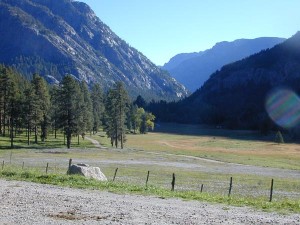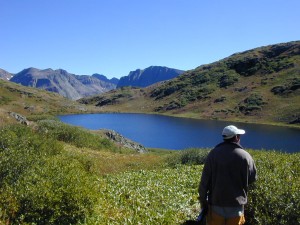- Rainbow
- Brown
- Brook
- Cutthroat
Real-Time Data
Fishing Info
- Caddis
- Mayfly
- Terrestrials
- Pat’s Rubberlegs
- Hares Ear
- Prince
- Pheasant Tail
- Peacock Caddis
- Hoppers
- Stimulators
- Trude
Late June-Oct
Weminuche Wilderness
Fly & lure only-2 fish limit upstream from Weminuche boundary
The southwestern half of the Weminuche Wilderness Area is drained by two major streams—Los Pinos and Florida Rivers—and their tributaries. Of these, Los Pinos watershed is the largest, covering a sprawling portion of the wilderness west of the Continental Divide. The Florida watershed is much smaller, draining a narrow glacial valley south of Columbine Pass.
Los Pinos River is known locally as the Pine. The river is divided into two distinct sections by the extensive impoundment of Vallecito Reservoir. The southern portion of the river below the reservoir is completely on private land and the Southern Ute Indian Reservation. Although fishing opportunities are limited through the private land, much of the river on Tribal land below Bayfield is open to fishing for permitted non-Tribal members. Between the reservoir and the Weminuche Wilderness the Pine flows through about 6 miles of private land, but from the wilderness boundary to the Continental Divide the Pine offers backcountry fly fishing at its finest. With over 50 miles of stream amid exquisite scenery, the possibilities for fishing adventures in the Los Pinos watershed are nearly limitless.
The trout found within the wilderness portion of the Pine watershed are exclusively wild fish. In the lower two-thirds of the river all common species of trout are found: rainbows, brookies, browns, and cutthroats. Above Willow Park mostly cutthroats and brook trout are found, along with an occasional rainbow. Below Flint Creek the average fish is around 8 to 10 inches. Trout up to 14 inches are common, with isolated larger fish. The entire watershed within the wilderness has special regulations. Angling is limited to flies and lures, and there is a bag and possession limit of two fish.

Begin the hike into the scenic granite canyon of the Pine and the public water above Granite Peak Ranch by following the Pine River Trail as it heads east parallel to a fence. Off to the right of the trail the river looks tantalizing: However, do not trespass. Stay on the trail until reaching the wilderness boundary, 3 miles from the start. In the wilderness, fine fly fishing is found everywhere on the river.
Above the wilderness boundary the Pine flows through a broad flat-bottomed canyon overlooked by sheer walls of blocky granite.With most anglers headed to more remote destinations, the stretch of river just above the wilderness boundary is well worth the effort for those looking for a day trip. Much of the river in the first 2 miles of public water is relatively open with easy casting, easy wading, and plenty of small brook trout and browns. Most trout are small, but a few nice fish up to 16 inches can be found.
Beyond the intersection with the Emerald Lake Trail, about 6 miles from the start, the Pine flows through a thundering canyon. Boulders, plunge pools, and waterfalls are found for the next 3 miles. Here anglers must scramble down from the trail to reach the river below. Frequently the canyon bottom is boxed in, so expect to work hard to fish this stretch of water. Anglers will find fewer fishermen in this stretch than in the more popular water above. It is not uncommon for the banks to be brushy in this stretch, and casting can be difficult. slick and the currents are fast. Scattered pools up to 8 feet deep and thousands of pockets make this stretch worth the effort.

In fast currents trout don’t have time to think much about food floating by, and so the fish in the pocket water are not very fussy. Use high-floating patterns designed for rough water. Select a Humpy, any of the Wulff series, or an Irresistible. Nymphs can also be effective in the pocket water. In the fast currents patterns should be large and have a bit of flash.
At Willow Park the Pine is still a small river from 30 to 40 feet wide. Anglers will find a twisting stream with dozens of turns. The river is typical meadow water with shallow gravel bars, meanders, and deep undercut banks. Riffles are common, as are smooth running slicks and stillwater bends. Few rocks break the surface of the water. The banks are mostly free from obstructions, and casting is easy from almost everywhere.Dry flies are an exciting way to fool the trout in the Willow Park area. Cast to rising fish, or prospect with attractors through the riffles.
About 2 miles above the upper end of Willow Park the river divides into Flint Creek and the main branch of the Pine. From here to the headwaters both streams are creek size, much smaller than below in Willow Park. Good trails parallel both streams. Above Flint Creek the Pine is about 10 feet wide; Flint Creek is a bit smaller. On the Pine, an impressive falls is located within a half-mile of the Flint Creek Trail junction. Both streams alternate between meadow and pocket water. Cutthroats and some rainbows ranging from 6 to 10 inches are found in the upper waters.
 The Flint Lakes lie at the head of Flint Creek about 16 miles from the trailhead. Nearby are Moon Lake and Rock Lake, beautiful cirque lakes tucked up against the peaks. Across the main branch of the Pine, Granite and Divide Lakes offer quality high-elevation lake fishing. This section of the Weminuche Wilderness holds more high-elevation lakes than one could fish in a lifetime.Most of the lakes in the area hold good populations of cutthroat rainbow, and brook trout.
The Flint Lakes lie at the head of Flint Creek about 16 miles from the trailhead. Nearby are Moon Lake and Rock Lake, beautiful cirque lakes tucked up against the peaks. Across the main branch of the Pine, Granite and Divide Lakes offer quality high-elevation lake fishing. This section of the Weminuche Wilderness holds more high-elevation lakes than one could fish in a lifetime.Most of the lakes in the area hold good populations of cutthroat rainbow, and brook trout.
Those seeking less of a wilderness experience should consider the possibilities of Vallecito Reservoir, where water from the Pine and Vallecito Creek is impounded. Aside from easy access, the main attraction of the lake is the large fish that swim in its water. Rainbow and brown trout as well as northern pike grow to monstrous proportions in the fertile water.
The Above Information on the Los Pinos River is excerpted from the book “Fly Fishing Southern Colorado” by Craig Martin, Tom Knopick and John Flick. It is reprinted courtesy of Pruett Publishing Company. All Rights Reserved.
Copyright 1997, 2007 by Craig Martin, Tom Knopick, John Flick

